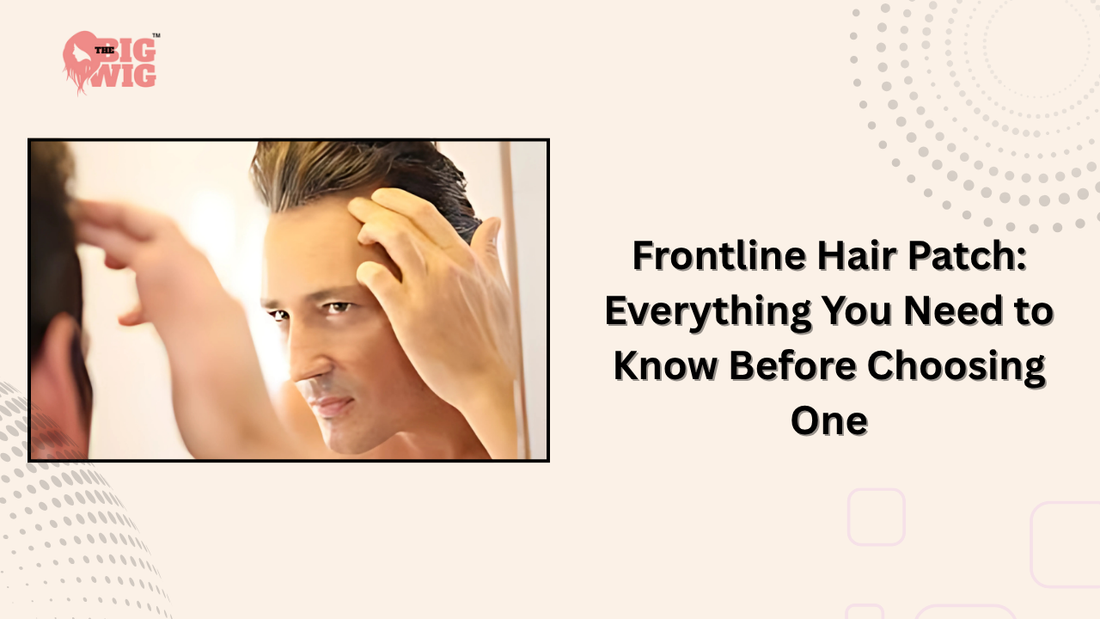
Frontline Hair Patch: Everything You Need to Know Before Choosing One
Share
Introduction
Hair loss is a big worry for lots of people, affecting millions around the globe every day. Whether its in your genes, the result of a health issue, or simply how you live, losing hair can mess with your head and self-esteem. One of the easiest, non-surgery fixes on the market, though, is the Frontline Hair Patch. This handy patch lays flat, blends well, and can give you back that little spring in your step you thought the bald spots had stolen. In the guide that follows, well walk you through the key facts to consider before picking a Frontline Patch.
What Is a Frontline Hair Patch?
Definition and Purpose
A Frontline Hair Patch is a light, non-surgical replacement made for folks who are losing hair mostly at the front hairline. Because it sits over only the thin spot instead of the whole head, the patch stays cool, feels easy to forget about, and usually matches your natural strands so well that most people never notice it.
Key Features
- Crafted specifically for the front hairline
- Available in real or high-quality synthetic fibres
- Secured with wig tape or gentle snap-on clips
-
Toned and styled to blend with your own hair
Who Should Consider a Frontline Hair Patch?
Ideal Candidates
- Anyone seeing a slow retreat of their hairline
- People dealing with frontal alopecia, patchy or diffuse
- Anyone wanting a quick, non-surgical fix
Benefits Over Other Solutions
- Usually cheaper than a full hair-transplant surgery
- Totally painless, done in minutes
- Lets you see full effect the moment it's applied.
Types of Frontline Patches
Based on Hair Material
Real-Human Hair Patches
Crafted from 100% human locks, these patches blend perfectly with your own hair. You can cut, color, or style them without losing durability.
Synthetic Hair Patches
Economical and lightweight, synthetic patches save money but resist high heat and may look less lifelike in certain lights.
Based on Attachment Method
With Hair-Wig Tape
This sturdy double-sided tape adheres the patch directly to the skin or scalp. Hair-wig tape grips firmly, stands up to moisture, and suits everyday wear.
With Hair-Patch Clips
Small comb-like clips stitched along the patch let you snap it in and out. Because they leave no residue, clips are best for anyone who prefers a quick, reusable fit.
How to Choose the Right Frontline Hair Patch
Consider Hair Type and Color
Always pick a patch that looks and feels like your own hair in shade, texture, and thickness.
Choose the Right Base Material
- Lace base-light, airy, and perfect for hot days.
- Monofilament base-gives the look of a living scalp.
- Silk base-smooth, soft, and very realistic.
Match Your Lifestyle
If you're active and sweat often, choose a breathable base and use strong Hair Wig Tape.
Application Process of Frontline Hair Patch
Step-by-Step Guide
- Clean the Scalp: Wash the area with a gentle, oil-removing cleanser and pat dry.
- Apply Hair Wig Tape: Place double-sided tape along the patch base or directly onto the scalp.
- Position the Patch: Set the patch so it follows your natural hairline.
- Secure the Patch: Press down firmly to bond the surface and tape together.
- Style as Desired: Use a fine-tooth comb, low-heat blower, or light gel to blend edges.
Tips for First-Time Users
- Consider enlisting a stylist for your first application. Accuracy matters.
- Pick a patch with built-in clips for quick adjustments later.
Maintenance and Care
Daily Care
Limit heat styling whenever possible. Gently work through tangles with a wide-tooth comb. Choose sulfate-free shampoo and conditioner.
Weekly Maintenance
Detach hair patch clips; clean and dry them. Replace wig tape with fresh strips.
Storage Tips
Keep the patch in a cool, dust-free place. Store it on a mannequin head to preserve shape.
Longevity of a Frontline Hair Patch
Factors Affecting Durability
Quality of raw materials. How often the patch is worn. Consistent maintenance.
Average Lifespan
Natural hair patches last six to twelve months. Synthetic versions last approximately three to six months.
Frontline Hair Patch vs. Other Hair Solutions
Hair Transplants
- Surgical, costly, yet offers a lasting fix
- Recovery can be lengthy and uncomfortable
Full Wigs
- Encloses the whole head
- Breathability falls short of Frontline Patch
Topical Treatments
- Outcomes are inconsistent across users
- Demand daily or near-daily application to stay effective
Expert Recommendations
Consult Before You Commit
Before deciding on a Frontline Hair Patch, sit down with a qualified hair-restoration specialist or dermatologist. Their guidance will point you toward the patch best suited to your scalp health and daily routine.
Trial Fittings
Experiment with several versions-attached by Hair Wig Tape or secured with Hair Patch Clips-so you can find the hold and comfort that feel right.
Conclusion
For people eager to restore a receding hairline without breaking the bank, the Frontline Hair Patch offers a swift, affordable option. Because it can be customized to fit different lifestyles, this non-surgical alternative is attracting growing attention. Whether you rely on the firm grip of Hair Wig Tape or the quick-release ease of Hair Patch Clips, selecting the right method can noticeably boost both your look and your self-assurance.
